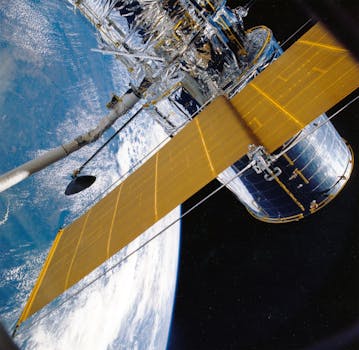
The Rise of Mega-Constellations: Latest Updates in Satellite Telecommunications
The Rise of Mega-Constellations: Latest Updates in Satellite Telecommunications. The launch of mega-constellations is transforming the satellite telecommunications industry, with thousands of satellites being launched into low Earth orbit to provide global internet coverage. This new era of space technology is expected to bring about significant improvements in communication services, including faster data transfer rates, lower latency, and increased connectivity.
The concept of mega-constellations was first introduced in the 1990s, but it wasn’t until recently that the technology became advanced enough to make it a reality. Companies such as SpaceX, OneWeb, and Amazon’s Kuiper Systems are leading the charge, with plans to launch tens of thousands of satellites into orbit over the next few years. These satellites will be used to provide a range of services, including broadband internet, mobile connectivity, and Earth observation.
How Mega-Constellations Work

Mega-constellations are networks of satellites that work together to provide continuous coverage of the Earth. Each satellite is equipped with a range of instruments, including antennas, transceivers, and processors, which allow it to communicate with other satellites and with ground stations. The satellites are launched into low Earth orbit, where they can take advantage of the reduced distance and latency to provide faster and more reliable communication services.
The satellites in a mega-constellation are typically arranged in a series of orbital planes, with each plane containing several dozen satellites. This arrangement allows the satellites to provide continuous coverage of the Earth, with each satellite passing over a particular region at regular intervals. The satellites can be used to provide a range of services, including broadband internet, mobile connectivity, and Earth observation.
Benefits of Mega-Constellations

The benefits of mega-constellations are numerous. They offer a range of advantages over traditional satellite systems, including faster data transfer rates, lower latency, and increased connectivity. They also offer a range of benefits for rural and remote areas, where traditional communication services may be limited or unavailable.
Mega-constellations also offer a range of benefits for the environment. They can be used to monitor climate change, track weather patterns, and provide early warning systems for natural disasters. They can also be used to support sustainable development, by providing communication services for remote communities and supporting the development of renewable energy sources.
Challenges and Concerns

Despite the many benefits of mega-constellations, there are also several challenges and concerns. One of the main concerns is the risk of collisions between satellites, which could result in a significant amount of debris in Earth’s orbit. There is also a risk of interference between satellites, which could disrupt communication services and cause problems for other satellite operators.
Another concern is the impact of mega-constellations on the environment. The launch of thousands of satellites into orbit could result in a significant amount of waste and pollution, and could also disrupt the natural environment of space. There are also concerns about the impact of mega-constellations on astronomy, as the sheer number of satellites could make it difficult for telescopes to detect faint objects in the sky.
Latest Updates and Developments

There have been several recent updates and developments in the field of mega-constellations. In 2020, SpaceX launched its first batch of satellites for its Starlink constellation, which is expected to provide global internet coverage. OneWeb also launched its first batch of satellites in 2020, and is planning to launch several hundred more over the next few years.
Amazon’s Kuiper Systems has also announced plans to launch a mega-constellation of satellites, which will provide broadband internet services to remote and underserved communities. The company has filed plans with the Federal Communications Commission (FCC) to launch 3,236 satellites into orbit, and is expected to begin launching satellites in the near future.
See more:





